Lifting Your Isuzu
The first thing off-roaders want to do to their Isuzu is lift it and fit bigger tires for more ground clearance. Options for lifting are limited, with CALMINI making the only lift kits availible for our vehicles.
To lift the front, CALMINI provides a set of longer A-arms to correct the geometry of the front end after you crank the torsion bars for lift. The kits also include other pieces such as extended brake lines, new bushings, a new cross-member, new torsion bars and hardware to complete the front end.
What's somewhat lacking in the kit from an off-roader's perspective is the way in which the rear is lifted. It's done with add-a-leaves and extended shackles. While this is fine for just lifting to fit larger tires (or for look), it still leaves a lot of things hanging down to rob ground clearance. The entire spring pack, u-bolt ends, clamping plate and the new add-a-leaves all hang down under the axle.
An alternate and somewhat more advantageous option for lifting the rear is a Spring-Over Axle (SOA) lift and that's what this article is going to focus on. Basically, it moves the leaves from under the axle to over the axle to provide the lift. Advantages include much more ground clearance under the axle tubes and, because you're not adding leaves, you retain the stock ride rather than getting a stiff jarring ride that add-a-leaves or re-arched springs can cause.
The biggest downside to a SOA lift is the increased potential for axle wrap when you really get on the gas. If you have a somewhat torquey V-8 you will have to deal with this. For us and our little four bangers, it's not much of a worry for the most part as long as you're careful while tooling around in low range.
The SOA also provides a lot of lift, around 6". While some people may really like this, it's a bit too much for those of us who wish the vehicle to remain somewhat level. The front can only be lifted by a max of about 3" so unless you're planning some major modifications like building new, longer A-arms or doing a solid axle swap up front, you'll want to reduce that 6" so something more like 3" - 4". Options for doing this will be detailed at the end.
The Spring-Over Lift
Documented here is the spring-over that I did on my '94 Amigo. Details are, of course, specific to this model, but the Amigo uses the same Isuzu Corporate 12 bolt rear axle that are found under different year Troopers, Rodeos and P'ups. Doing a SOA looked pretty simple to me, but I knew there were bound to be a myrid of things I hadn't thought of that would come up. After talking with Randy Burleson and George Reiswig who had both performed this conversion on their Amigos, I felt I had enough info and confidence to start hacking as well.
Each of us ended up doing things a little bit differently, mainly in the area of reducing the amount of lift and in things like shock mounting positions and choice of spring pads and clamping plates. For the most part though, gleaning information from them made the prospect much easier to comprehend and commit to.
Getting Started
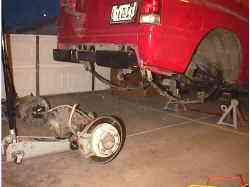 The
first step is to get the back of the vehicle up in the air and secure
it with jack stands, wheel chocks, etc. You may want to lock the
hubs and put it in 1st gear, 4-low as well so the front wheels keep it
in place. Leave the parking brake off as its cables have to be
removed and it won't do any good anyways since the rear axles is off
the ground. It's best if the stands used are the heaviest duty
ones you can find as these have a larger base on them.
Place the stands under the frame far enough in front of the rear axle
to get it well into the air. This makes it easier to roll the
axle out backwards under the truck.
The
first step is to get the back of the vehicle up in the air and secure
it with jack stands, wheel chocks, etc. You may want to lock the
hubs and put it in 1st gear, 4-low as well so the front wheels keep it
in place. Leave the parking brake off as its cables have to be
removed and it won't do any good anyways since the rear axles is off
the ground. It's best if the stands used are the heaviest duty
ones you can find as these have a larger base on them.
Place the stands under the frame far enough in front of the rear axle
to get it well into the air. This makes it easier to roll the
axle out backwards under the truck.
Then start disconnecting the lines to the axle. The parking brake cables, hydraulic brake line, diff breather hose and the ABS sensor wire (if you have ABS) all have to come off. You might want to find a package of small assorted sized corks to plug the hard brake line on the frame to keep it from continually dripping on you. I just wrapped it with plastic and a rubber band and that worked alright. Remove the shocks and the u-bolts and the axle is free, sitting on the springs.
I also removed the speghetti mess of an exhaust system it had in preperation for a new one when I was done. Things look pretty roomy once you get all these things out. Note that the fuel tank and exhaust don't have to come out to do a SOA. I was doing some modifications to them at the same time so I took it all out to make it easier to work.
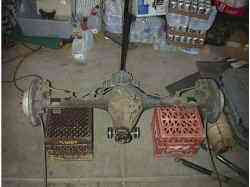 After
rolling the axle out you can support it with milk crates, blocks or
whatever else you have available to make it a little easier to work
on. Depending on what you plan to use for spring pads on top of
the axle, you may need to remove the old ones from the bottom.
After
rolling the axle out you can support it with milk crates, blocks or
whatever else you have available to make it a little easier to work
on. Depending on what you plan to use for spring pads on top of
the axle, you may need to remove the old ones from the bottom.
To remove the old pads, use a small wheel grinder with the thinnest wheel you can find or better yet use an air driven cutoff wheel. A Dremel tool with one of those large 2" or so cut-off wheels would probably work pretty good too. There are two weld beads on the old pads, one on the front and one on the back. Carefully grind away the weld on one side and watch that you don't go so deep as to grind into the axle tube. You only want to go deep enough to cut the weld.
If you look real close, you'll probably see a hair line crack where you get completely through the weld. You can use a chisel to break it loose when it starts to look close. It'll make a little "click" and pop open 1/8" or so. Do the same to the other side and you can remove the spring pad. Clean up the remaining weld on the axle tube with a grinder to make it smooth again.
Making the new spring pads.
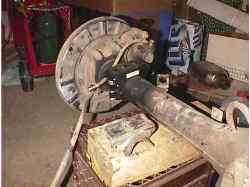 This
is the new spring pad that I used in place on top of the axle.
The old pad from the bottom that was ground off is sitting on the
block in the foreground.
This
is the new spring pad that I used in place on top of the axle.
The old pad from the bottom that was ground off is sitting on the
block in the foreground.
These new pads were from AFCO Racing. They provide a lot of stuff for circle track racing but have a lot of suspension pieces 4 wheelers may find useful. These pads are 2?" wide, made from ?" material and fit a 3" diameter axle tube. Rather than welding on, they clamp firmly to the axle tube (hence, the need to remove the old pads) which also means they can easily be fine-tuned for adjusting the pinion angle after the lift.
If you choose to use weld on pads, I'd suggest *not* welding them on at this stage. Leave them loose and bolt everything up with the u-bolts when you're trial fitting things back together and check the pinion angle. With the pads loose, you can use a jack under the pinion to get the angle correct. Once it's set, tack weld the pads and pull the axle back out to weld them up good.
One thing go be careful with: Our axle tubes are not really 3" in diameter. They're actually 75 mm, which comes out to about 2.95". Clamping down on them with these AFCO pads as-is causes the bottom half of the clamp to tighten against the upper half before getting a firm grip on the axle tube. Grind off a small portion from the ends of the upper and lower halves so they'll clamp tight to the axle tube with a small gap between them. It doesn't take much. Maybe a 16th of an inch or so off each of their ends is all it takes. You may want to leave a small bevel on the inside edge as well, to reduce the risk of it digging into the axle tube.
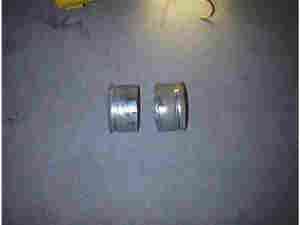
This is the old u-bolt plate that goes between the u-bolts and the
axle to prevent it from creasing when tightening the u-bolts down.
You can't use them as is after the spring over if you decide to
use the AFCO clamps or if you leave the old pads on the bottom of the
axle tubes. To make them fit, cut the plates down the middle and
install them with the raised ridge between the u-bolt and the spring
pad clamp (or old pad) to protect the axle tube as before.
Putting the raised edge inward will prevent them from working loose
and dropping out. Note the completed assembly below for a better
picture.
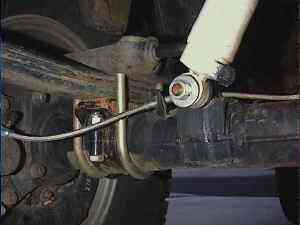
After cleaning up the axle and getting the new pads in place, tighten
up the pads so they're snug and at approximately the correct angle.
Eyeballing it should be close enough but be aware that it's better to
have the pinion pointing down too far than up. The reason being
that after you get the springs clamped to it and get the wheels on and
weight on the axle, you can use a jack under the pinion to rotate it
up until you get the angle you want before tightening things up for
good. It's not as easy to get something up above the pinion to
force it down.
After getting the axle back in for it's trial fitting with the truck's weight on it, use a magnetic angle finder on the output flange of the transfer case and the pinion to adjust the pinion angle accordingly.
You might want to climb in back and jump up and down a few times to make sure the springs and pads settle in completely. You could drive it, but I wouldn't recommend taking it too far. If you're using the clamps, torque the u-bolts and clamps down and you're done with the hard part. If using weld on pads, tack them in place and either just remove the u-bolts or pull the whole axle back out to weld them on the rest of the way. When done, slip the axle back in place and tighten the u-bolts down.
Link
to options for clamping sequence (seperate document). Using
stock plates, make your own, etc. ![]()
Mounting the shocks.
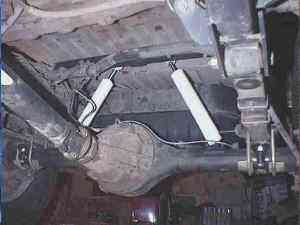 The
next step is to re-attach all the lines and the shocks.
The
next step is to re-attach all the lines and the shocks.
For my shocks, I chose Rancho 9000s and made my own upper and lower mounts for them. The mounts that can be used will depend on how much fabrication you do and how you choose to clamp your springs on top of the axle. It is possible to use the stock upper and lower mounts if you use the stock clamping plate in the correct manner. I chose to make my own mounts because I was making the crossmember anyways to support my new fuel tank skid plate and because it allows me to use the longest possible shocks and mount them for the maximum amount of travel.
Link
to options for shock mounts (seperate doc). ![]()
New brake lines.
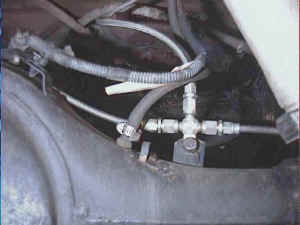 I
used Earl's for the brake lines and fittings. They're braided
stainless steel hose good for 450? F and 2000 PSI. The
"T" on the axle uses AN fittings and metric fittings are
used at the calipers and where it attaches to the hard line above the
axle.
I
used Earl's for the brake lines and fittings. They're braided
stainless steel hose good for 450? F and 2000 PSI. The
"T" on the axle uses AN fittings and metric fittings are
used at the calipers and where it attaches to the hard line above the
axle.
Figuring out the parts I needed for the lines was not an easy task. You can't just go down to your local hardware or speed shop to pick out what you need. Nobody stocks metric fittings. This is further complicated because of the different flares you can use. After several phone calls to Earl's and Aeroquip, two orders and a bunch of metric bolts to figure out banjo bolt sizes, I finally got the pieces needed. To make things easier, here's the diagram and part numbers you'll need from Earl's.
Reducing the lift.
As mentioned before, the SOA lift by itself will give about 6" of lift. Randy Burleson, George Reiswig and myself all did things a little bit differently to reduce the amount of lift. Details for our different methods and what we found that did and did not work are here.
Final notes.
AFCO clamps.
If you're going to use the AFCO clamp on pads, you may want to consider welding them in place (or at least tack weld them) after you get the pinion angle right. While in Moab this spring Randy found out the hard way that these clamps may not hold tightly enough. While trying to climb a steep little ledge, the clamps couldn't hold under the torque of first gear, low range and 34" Swampers. The axle spun in the clamps and ended up pointing about 45? up instead of nearly level like it should.
Several things led to this though. The clamps are slightly larger than our axles so they hadn't bottomed out on the axle tube as well as they should have. He had painted his axle with POR-15 (a very hard and slick rust preventative paint) before attaching the clamps. And he was running the largest and most aggressive tires of us all; 34" Super Swampers.
On mine, I had ground the ends of the clamps down a bit so they clamp firmly to the axle tube and I used a standard flat black spray paint on the axle tube that isn't nearly as slick as POR-15. At Moab and up to this point so far, I have managed to run without welded clamps and haven't had a problem. I'm running 33" Mickey Thompsons that measure a true 32.2" or so. Randy's Swampers I believe, run a true 34".

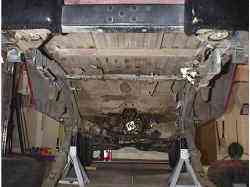

 Your Privacy Choices
Your Privacy Choices